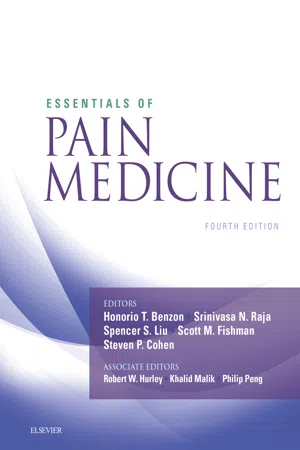
Essentials of Pain Medicine E-Book
- 688 pages
- English
- ePUB (mobile friendly)
- Available on iOS & Android
Essentials of Pain Medicine E-Book
About this book
Accessible, concise, and clinically focused, Essentials of Pain Medicine, 4th Edition, by Drs. Honorio T. Benzon, Srinivasa N. Raja, Scott M. Fishman, Spencer S. Liu, and Steven P. Cohen, presents a complete, full-color overview of today's theory and practice of pain medicine and regional anesthesia. It provides practical guidance on the full range of today's pharmacologic, interventional, neuromodulative, physiotherapeutic, and psychological management options for the evaluation, treatment, and rehabilitation of persons in pain.- Covers all you need to know to stay up to date in practice and excel at examinations – everything from basic considerations through local anesthetics, nerve block techniques, acupuncture, cancer pain, and much more.- Uses a practical, quick-reference format with short, easy-to-read chapters.- Presents the management of pain for every setting where it is practiced, including the emergency room, the critical care unit, and the pain clinic.- Features hundreds of diagrams, illustrations, summary charts and tables that clarify key information and injection techniques – now in full color for the first time.- Includes the latest best management techniques, including joint injections, ultrasound-guided therapies, and new pharmacologic agents (such as topical analgesics).- Discusses recent global developments regarding opioid induced hyperalgesia, addiction and substance abuse, neuromodulation and pain management, and identification of specific targets for molecular pain.- Expert Consult™ eBook version included with purchase. This enhanced eBook experience allows you to search all of the text, figures, Q&As, and references from the book on a variety of devices.
Frequently asked questions
- Essential is ideal for learners and professionals who enjoy exploring a wide range of subjects. Access the Essential Library with 800,000+ trusted titles and best-sellers across business, personal growth, and the humanities. Includes unlimited reading time and Standard Read Aloud voice.
- Complete: Perfect for advanced learners and researchers needing full, unrestricted access. Unlock 1.4M+ books across hundreds of subjects, including academic and specialized titles. The Complete Plan also includes advanced features like Premium Read Aloud and Research Assistant.
Please note we cannot support devices running on iOS 13 and Android 7 or earlier. Learn more about using the app.
Information
Interlaminar Epidural Steroid Injections
Introduction
Technique
Table of contents
- Cover image
- Title page
- Table of Contents
- Copyright
- Dedication
- Preface
- List of Contributors
- Section I. Basic Considerations
- Section II. Clinical Evaluation and Diagnostic Examinations
- Section III. Perioperative Pain Management
- Section IV. Chronic Pain Syndromes
- Section V. Cancer Pain and Pain in Special Situations
- Section VI. Pharmacology and Pharmacologic Modalities
- Section VII. Therapeutic Interventions
- Section VIII. Interventional Techniques for Pain Management
- Section IX. Other Nerve Blocks in Pain Medicine
- Index